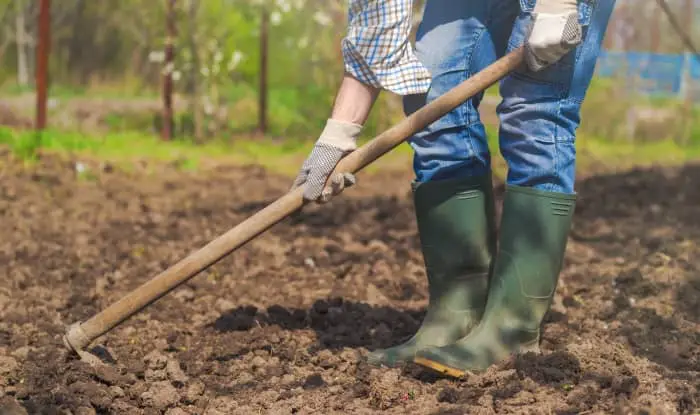There are many different types of garden hoes available. Some are made for digging, some specialize in weeding, and some can carry out a variety of garden jobs.
In this article, we look at 17 of the most common and useful hoes for yard work. We show you exactly what to expect from each type, so you can choose the tool that’s best suited to the work you need to get done.
Let’s dive in.
Types Of Garden Hoe
Depending on the style, you can fit hoes into 3 categories: digging hoes, scuffle hoes, and draw hoes.
Digging Hoes
Digging hoes are a traditional type of hoe used for thousands of years in agriculture. Digging hoes have a heavy blade at the end of a long handle that chops into the ground at a 45-degree angle.
You swing a digging hoe from waist height, and the heavy blade helps generate the power needed to break into the soil. After chopping the hoe into the soil, pull it towards you to move and shape the earth.
Draw Hoes
Draw hoes feature a rectangular-shaped blade at the end of the handle. To cut weeds and move soil, chop the draw hoe into the ground, then scrape it towards you. By scraping the soil surface, you can sever weed stems. If you scrape below the soil surface, you can sometimes pull shallow-rooted weeds from the ground.
In contrast to digging hoes, draw hoes have a light hoe head as the tool is not designed for heavy digging work. But you can use a draw hoe for manipulating loose soil and breaking up clumps.
Some draw hoes have an adjustable neck that allows you to set the angle of the blade for better results. But heavy-duty draw hoes, strong enough to hack through thick weeds, have a fixed blade. So it’s important to choose a heavy-duty draw hoe with a long enough handle, giving you a choice of holding positions to create the best angle for completing the job at hand.
Scuffle Hoes
Scuffle hoes are designed primarily for weeding. By pushing and pulling the hoe blade underneath the soil surface you can cut plant stems away from the roots. Scuffle hoes are most effective in loose or soft soil and aren’t meant for use in hard soil.
Scuffle hoes are precision weeding tools that are easy to use around desirable plants without causing them harm. Many people like using scuffle hoes for weeding because they don’t place as much strain on your back as other types of hoes. You can also use scuffle hoes for light manipulation of the soil.
Paddle hoe
A paddle hoe is one of the most commonly used hoes. It’s the type of hoe many people picture when imagining a garden hoe. A paddle hoe has a rectangular blade at the end of its long handle set close to a 90-degree angle.
A paddle hoe is a versatile tool that you can use for weeding as well as moving and shaping the soil. To use a paddle hoe, chop the blade into the ground, then draw the blade towards you, cutting through weed stems and moving soil.
Eye Hoe
Eye hoes are a type of draw hoe. They’re also sometimes called peasant hoes or scovil hoes.
Eye hoes are traditional tools with a design that dates back thousands of years. But they’re so effective that they’re still used today all over the world. Eye hoes feature a blade with a tapered collar and an eye at the top. The handle, usually made from smooth ash sapling, fits through the eye.
You can use an eye hoe for hacking through clumps of grass and weeds. Or scraping the soil surface to cut the stems of small young weeds and dig up weed seedlings.
Because the tool has a heavy-duty blade, you can also use an eye hoe for breaking ground by swinging the blade with a chopping motion and prying loose a clump of earth.
American Pattern Garden Hoe
The American pattern garden hoe is a draw hoe. It has a common design that you’ll see in big box stores. It’s a smaller and lighter tool than an eye hoe, with a smaller head, and many people find this type of hoe easier to handle. You can use the tool for planting, cultivating, weeding, and moving soil.
Heart-Shaped Hoe
As the name suggests, heart-shaped hoes have a small heart-shaped blade at the end of a long handle. Weeding with a heart-shaped hoe involves pushing and pulling just beneath soil or mulch to cut weed stems.
The pointed shape of the blade makes it easy to weed in tight spaces without causing damage to nearby desirable plants. And you can use the point to easily create soil furrows for planting seeds, break up clumps of soil, and dig up root vegetables such as potatoes.
A heart-shaped hoe has a forward-facing blade that sits flat on top of the soil when at rest. This makes it comfortable to use while standing without bending your back.
Field Hoe
A field hoe is a great choice for heavy work such as chopping down dense, well-established weeds, digging into hard earth, cutting through sod, and even clearing small trees and shrubs.
A field hoe has a heavy-duty blade and a 40-60 inch handle, helping you generate power in your swings. High-quality models feature a handle socket and hoe blade welded together to stabilize the hoe, so you can apply more force without worrying about breaking the tool.
Collinear Hoe
Also known as onion hoes, collinear hoes are a creation of Eliot Coleman and have an ergonomic design making them easy and enjoyable to use. A collinear hoe is a sweeping hoe that enables you to weed while standing straight. To use a collinear hoe, you draw the blade towards you in small sweeping motions, cutting weed stems just beneath the soil surface.
Collinear hoes have a thin rectangular blade, and you hold them with an upright posture. Small drawing motions are sufficient to clear weeds, making it a good tool to use in small spaces between plants because you can work with precision.
Swan Neck Hoe
A swan neck hoe has a longer and lighter neck than most regular draw hoes. And it’s usually possible to adjust the neck angle to improve your performance as you scrape through the top layer of soil cutting weeds. You can also use a swan-neck hoe for cultivating the soil.
To use a swan-neck hoe, keep your back straight while hoeing, hold the handle like a broom, and draw the blade towards you.
The swan neck on the tool makes it easy to hang this type of gardening hoe for storage.
Diamond Hoe
A diamond hoe is a type of scuffle hoe. It has four sharp sides that make it easy to cut weeds with a push-pull motion on both backward and forward strokes. Hold the end of the handle and stand upright as you work for fast and easy weeding. You can use the diamond points to snip weeds in small spaces between desirable plants.
Swage Hoe
Swage hoes are also known as Ploskorez hoes. Originally from Russia, swage hoes are one of the most popular and versatile types of garden hoes. A swage hoe is a compact hoe that makes it easy to weed between plant rows. An adjustable blade allows you to set the best angle for different tasks.
A swage hoe is a gardening hoe that features a narrow blade with a pointed tip and sharp sides. The hoe blade is sharp enough to slice the stems of mature weeds. Use the tip for tight spaces and the flat blade for wide spaces. A swage hoe is a precision weeder, so this kind of hoe is not designed for cutting through sod or digging into the soil.
Trapezoid Hoe
A trapezoid hoe is a draw hoe, and as the name suggests, the blade is in the shape of a trapezoid. You can use the sharp pointed corners to pull up roots. Trapezoid hoes often feature a replaceable spring-steel blade attached to the steel head.
Trapezoid hoes are good for working in tight spaces between rows of plants to remove weeds using a scraping motion.
Stirrup Hoe
A stirrup hoe is one of the most popular types of weeding hoes. Other names for a stirrup hoe include action hoe, oscillating hoe, and hula hoe. The head shape resembles a stirrup on a saddle.
A stirrup hoe is a scuffle hoe. To use a stirrup hoe, you slide the blade underneath the soil surface, then use a push-pull motion to sever weed stems from the roots.
An advantage of using a stirrup hoe for weeding is that it doesn’t cause much soil disturbance, resulting in fewer weed seeds brought to the surface where they can germinate.
Dutch Hoe
Dutch hoes are easy to use for weeding. Dutch hoes are push hoes, and because they have a forward-facing blade, you can weed while standing upright without bending your back. Push and pull the hoe blade beneath the soil surface to cut weed stems.
You can also use a Dutch hoe to create furrows for seeds and for mixing in soil amendments.
Grub Hoe
Grub hoes are digging hoes that find many uses in farming and gardening. Grub hoes feature a heavy-duty perpendicular blade attached to a long handle. Similar to a mattock, grub hoes are good for breaking hard ground and digging trenches. You can also use a grub hoe to till soil, chop down weeds, and remove turfgrass.
You use a grub hoe with a chopping motion, swinging it down from waist height into the ground. After chopping the blade into the ground, pull the head of the tool towards you to move the soil and drag out weeds.
Warren Hoe
Also called a ridging hoe, a Warren hoe has a triangular-shaped blade with a sharp point. It’s a useful tool for weeding in tight spaces, but the main use of this type of gardening hoe is for creating long straight furrows to plant seeds.
You can also use a Warren hoe for loosening and tilling the soil and for earthing up vegetables.
Grape Hoe
A grape hoe is a heavy-duty hoe with a sharp wide blade that makes it easy to scrape away small young weeds. You can also use a grape hoe for chopping through thick mature weeds. It’s not a precision weeding tool like a scuffle hoe. Instead, it’s a good weeding tool for quickly clearing weeds from large spaces and garden rows.
A grape hoe resembles a grub hoe. And you can use a grape hoe for digging into the soil, then moving and shaping it to create garden beds and paths. You can also use a grape hoe to chop through woody perennial weeds and vines and to remove sod.
CobraHead Hoe
A CobraHead hoe is a tool designed for precision weeding. You can also use this type of garden hoe for soil cultivation, digging into the soil, and making furrows. The blade’s sharp point easily gets into tight spaces and can pull out weeds with small taproots. You can also use it to break through tough soil crust.
When using the tool, the basic motion is the same as when using a hoe, digging the blade into the soil and then pulling towards you.
You can get the CobraHead weeder as a short-handled garden tool and a long-handled hoe.
Korean Ho-Mi Hoe
The Korean ho-mi is a short-handled tool that’s ideal for weeding, removing grass, and digging. The angled blade easily cuts through firm soil. And you can use the ho-mi to quickly create planting holes and furrows. Then use the blade to cover the seeds with soil.


















